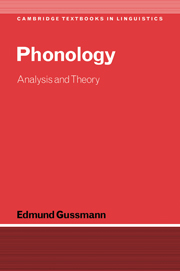Book contents
- Frontmatter
- Contents
- Preface
- List of abbreviations
- 1 Sounds and segments
- 2 The melody and the skeleton
- 3 Domains and phonological regularities
- 4 The syllable
- 5 More on codas
- 6 Some segmental regularities
- 7 Syllable structure and phonological effects: quantity in Icelandic
- 8 Segmental double agents
- 9 Words and feet: stress in Munster Irish
- Conclusion
- Appendix The phonetic alphabet of the International Phonetic Association
- References
- Index
3 - Domains and phonological regularities
Published online by Cambridge University Press: 05 June 2012
- Frontmatter
- Contents
- Preface
- List of abbreviations
- 1 Sounds and segments
- 2 The melody and the skeleton
- 3 Domains and phonological regularities
- 4 The syllable
- 5 More on codas
- 6 Some segmental regularities
- 7 Syllable structure and phonological effects: quantity in Icelandic
- 8 Segmental double agents
- 9 Words and feet: stress in Munster Irish
- Conclusion
- Appendix The phonetic alphabet of the International Phonetic Association
- References
- Index
Summary
Introduction
In the preceding two chapters we have seen that phonological representations of words consist of two separate tiers of which one – the skeleton – captures the linear and temporal order of units, while the other – the melody – provides the phonetic substance associated with skeletal positions. Crucially, we have seen that there does not have to be a one-to-one correspondence between the units of the melodic and the units of the skeletal subrepresentation: a certain melodic property may be associated with more than one position and, conversely, skeletal positions may have no melody attached to them and thus remain empty. Phonological regularities can hold between units of either of the two tiers or may invoke more complex structures at both levels. In subsequent chapters we will explore in greater detail the nature of phonological regularities by analysing individual phonological problems. The complexity of the problems will increase since it seldom happens that phonological phenomena can be formulated as single regularities: normally they are intertwined with other phenomena, and this often means that in order to interpret what looks like a simple regularity we need to study a number of other factors. Before we plunge into such complex patterns and the concomitant theoretical machinery we need to clear the stage a bit more.
In the present chapter we shall consider, among other things, the scope of phonological regularities. So far we have been assuming without justification that words constitute the domain of phonological phenomena.
- Type
- Chapter
- Information
- PhonologyAnalysis and Theory, pp. 45 - 65Publisher: Cambridge University PressPrint publication year: 2002
- 1
- Cited by



